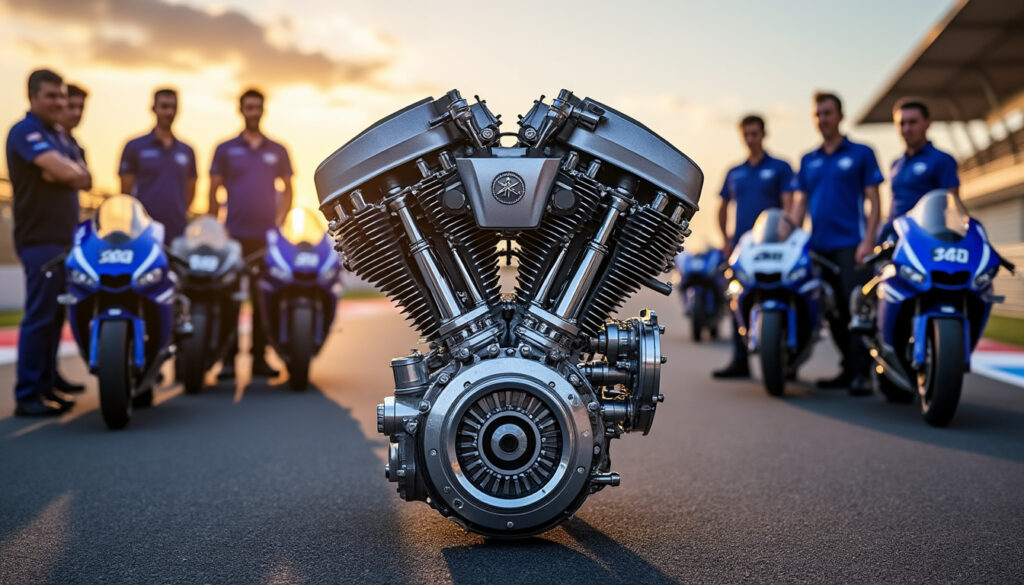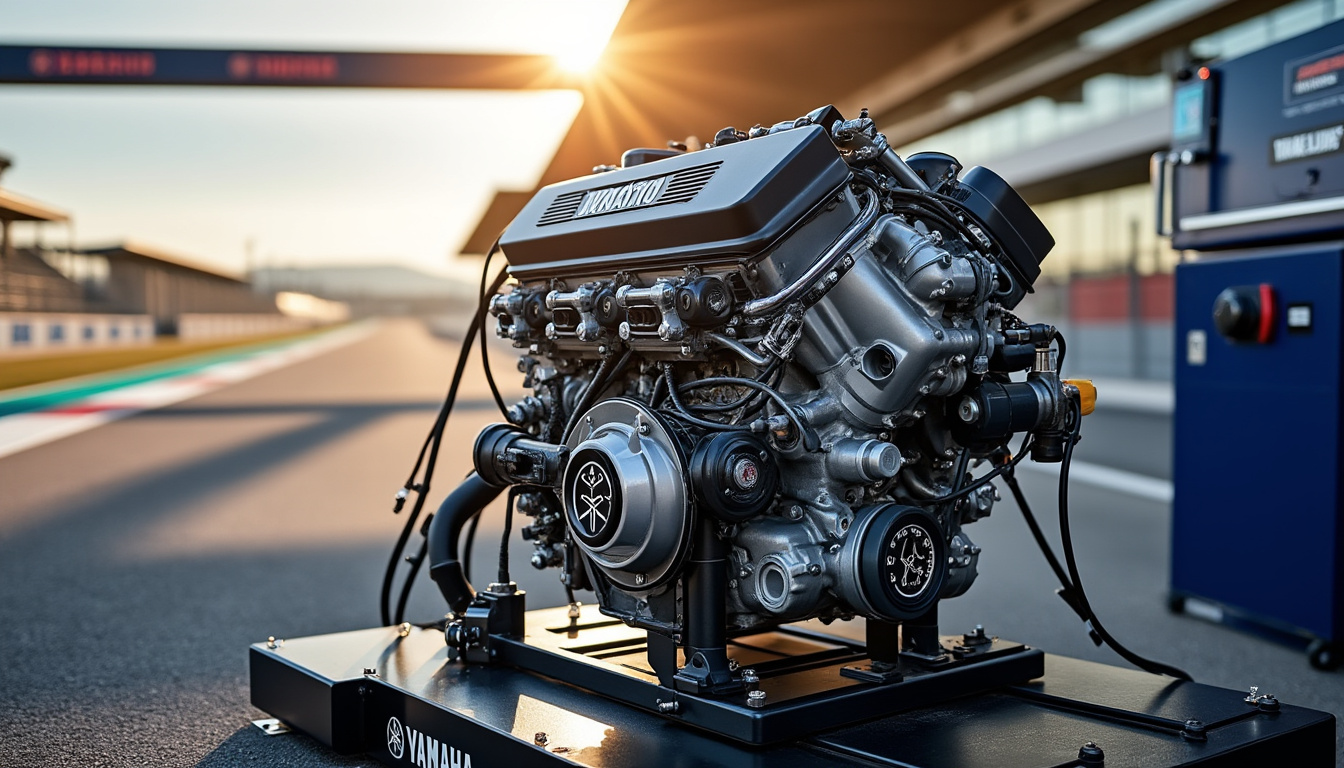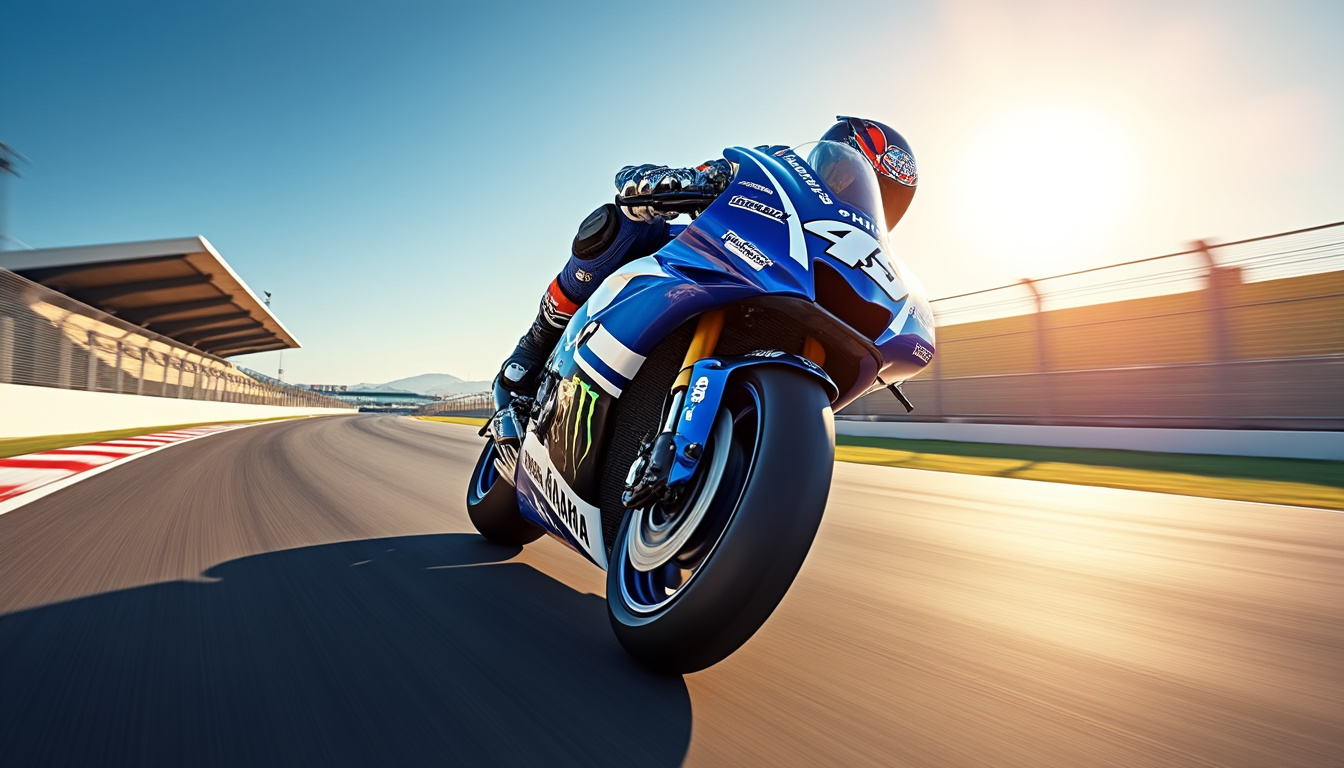Yamaha is testing its latest V4 engine at the Valencia circuit

Yamaha, a major player in the motorsports field, has recently turned a new chapter in its history by taking to the Valencia circuit to test its brand new V4 engine. This initiative marks a significant turning point for the brand, which has long distinguished itself with its inline four-cylinder engine. This innovative project showcases Yamaha's ambition to renew itself in the face of competition. In this article, we will explore the many aspects of this experience, its implications for the brand's motorcycle performance, and the impact of this technology on the future of MotoGP competition.
Context of Yamaha's evolution towards the V4 engine
The landscape of MotoGP has evolved over the years, and Yamaha has long relied on its inline four-cylinder engine. However, with the rise of competition from other brands such as Ducati and Honda, which have successfully adopted V4 architectures, pressure has become palpable. This shift to a different architecture appears to be a direct response to the evolution of racing technologies. Since the introduction of four-stroke engines in 2002, Yamaha has established itself as a key player, but this consistency now seems insufficient to maintain the same level of performance.Why this change? Here are some elements of response:
- Improvement in traction: The V4 engine has a mass distribution that promotes better traction.
- Aerodynamic efficiency: The compact design of the V4 optimizes the aerodynamics of the motorcycle, which is crucial for racing performance.
- Competitive pressure: With competitors like Ducati demonstrating the advantages of the V4, Yamaha must innovate to remain competitive.
- Rider aspirations: Yamaha riders, such as Fabio Quartararo, have expressed their desire for a more powerful motorcycle, leading to this experimentation.
This change would have consequences for the design philosophy at Yamaha. Long committed to innovation, the brand advocates the idea that technology must always move forward. The architecture of the V4 engine could offer a strategic advantage to Yamaha in the future, particularly with the ingenuity and experience accumulated in the development of new engines. Serious planning for the necessary tests and adjustments for this fundamental change is underway.

The first tests of the V4 engine in Valencia
At the Ricardo Tormo circuit in Valencia, Yamaha showcased the capabilities of its V4 engine. For this testing session, riders Cal Crutchlow and Augusto Fernandez were chosen to evaluate this new model. The testing context is indeed significant, not only for Yamaha but for the entire MotoGP. Aside from it being a test, it represents an opportunity to assess performance in real conditions, in a competitive setting, where even rivals like Honda were also present.
The communication from Yamaha's technical director, Max Bartolini, highlights the importance of this testing phase. He stated: “We have started testing the V4 engine”, indicating that official riders should also participate in the tests as soon as the conditions and performance are satisfactory. The tests in Valencia serve as a platform for the upcoming developments and adjustments of the engine, contributing to Yamaha's overall strategy for its return to the top of competition.
Technology and innovation behind the V4 engine
The development of a V4 engine is not limited simply to the cylinder configuration; it encompasses a multitude of advanced technologies. Indeed, Yamaha must integrate several technical elements to ensure that this engine can compete with those of its rivals. Among these innovations are:
- Inclined cylinders: The V4 configuration optimizes space and reduces the weight of the motorcycle.
- Advanced electronic management: The harmony between the engine and the electronic management system is crucial for optimizing performance. This includes dynamic adjustments for traction control, engine braking, and acceleration.
- Lightweight materials: The use of composite materials and lightweight aluminum reduces the weight of the engine without compromising its durability.
This targeted approach allows Yamaha to integrate refinements that can make a difference on the track. The V4 engine, for example, is designed to generate greater torque in the lower and mid-range RPMs, which can result in better acceleration out of corners. By countering competitive forces, Yamaha is committed to refreshing its reputation in the MotoGP world.
| Characteristics of Yamaha's V4 engine | Details |
|---|---|
| Configuration | V4, 1000 cc |
| Weight | Lightened through the use of composite materials |
| Electronic management | Dynamic control of torque and braking |
| Aimed performance | Increased traction and improved aerodynamics |
These innovations pave the way for further potential improvements in the Yamaha range. The technology established here could eventually influence the development of other motorcycles from the brand, offering more power and flexibility in riding.
Impacts on Yamaha riders' performances
The potential impact of this engine on Yamaha riders' performances is a hot topic. For racers like Fabio Quartararo, whose performances depend heavily on engine behavior, expectations are particularly high. The switch to the V4 could affect several facets of the motorcycle, including:
- Cornering agility: A lighter engine could improve the maneuverability of the M1.
- Engine RPM: Improved torque can allow for better corner exits, providing an advantage on tight circuits.
- Durability: If the V4 can maintain its power without overheating, it could offer more confidence to riders during races.
The success of these tests in Valencia cannot be underestimated. Yamaha understands that the V4 must be optimized not only for sheer speed but also for the quality of riding, which is a decisive factor for riders during races. The V4 technology could thus very well be the key for Yamaha to return to the forefront in MotoGP.

Rider feedback on the circuit
The feedback from riders after the tests is often revealing of the effectiveness of a new engine. Fabien Quartararo, who has struggled in some races over the past few seasons, was optimistic: “If the V4 delivers what we hope, it could truly change the game”. Riders will also need to play a role in the ongoing development of this engine to ensure it meets their performance needs.
| Riders and Tests | Evaluations |
|---|---|
| Cal Crutchlow | Positive feedback on maneuverability and power |
| Augusto Fernandez | Focus on acceleration and traction |
| Fabio Quartararo | High expectations for upcoming races |
By observing the feedback from the riders and their impressions, Yamaha seems to be on the right track to turn this new architecture into a competitive advantage. The next phase will involve refining the engine, addressing any inadequacies and adjustments as the riders familiarize themselves with the nuances of the performance offered by the V4.
Anticipations for the future of MotoGP with Yamaha's V4
The future of MotoGP for Yamaha looks promising with the imminent arrival of the V4 engine. As the 2026 season looms on the horizon, some crucial questions remain:
- Rapid adoption: Will Yamaha be able to integrate the V4 into the competition calendar?
- Upcoming regulations: Will the transition to a V4 engine align with the regulatory changes in 2027, which impose a reduction in engine displacement?
- Performance sustainability: Will the M1 V4 remain competitive against the adjustments of other manufacturers?
Yamaha finds itself in a position where every step must be carefully measured. Max Bartolini's communication is clear on this matter, emphasizing that the transition to the V4 must be a decisive success. He added: “If the V4 engine on the motorcycle is more performant than the current one, we will move forward”. This provides a concrete insight into the expectations placed on this new engine.
| Key elements for the success of Yamaha's V4 | Importance |
|---|---|
| In-depth testing | Essential for understanding the dynamics of the motorcycle |
| Adaptation to regulations | Must align with future directions of the competition |
| Rider feedback | Critical for the success of engine development |
Yamaha's ability to navigate this transition will determine both its success on the MotoGP stage and set the future direction for other brands in the competition. Any change in the venerable world of motorsport is an opportunity to celebrate innovation, and Yamaha seems well-positioned to realize its full potential in this exciting venture. It remains to be seen whether the Valencia circuit will mark the beginning of a new era powered by the V4.
Source: www.moto-net.com
Leave a Reply



Articles relatifs